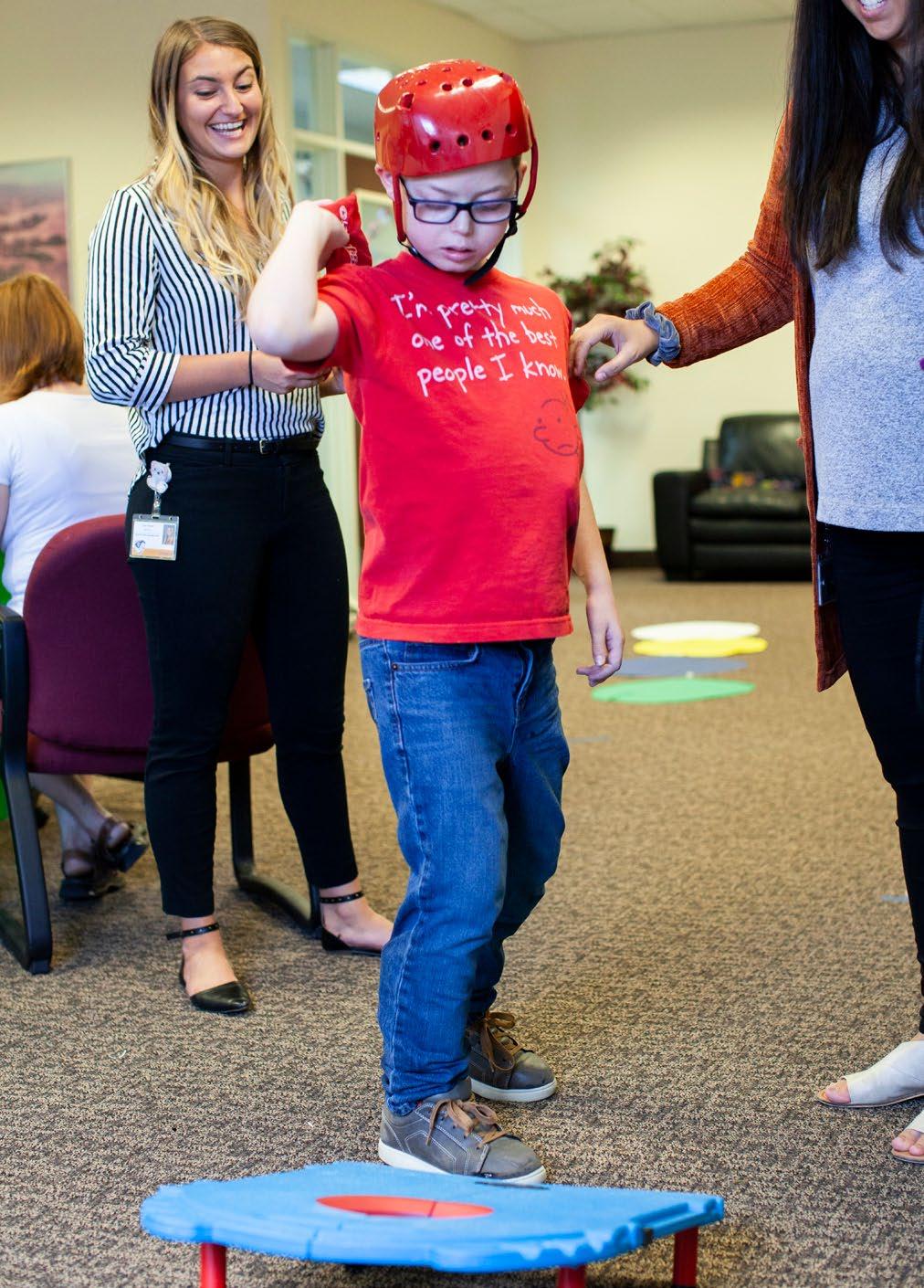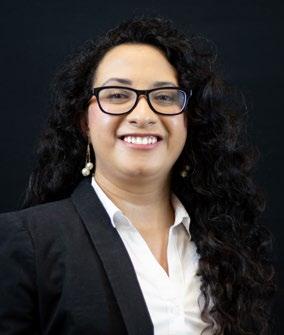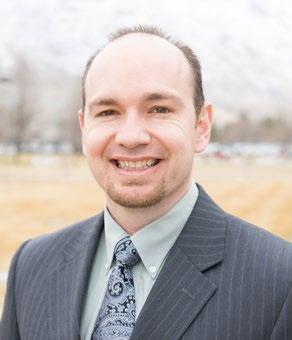
6 minute read
CRC Staff








Center for Communication Disorders
The Center for Communication Disorders (CCD) is responsible to two different entities: the RMU Foundation and the Master of Science in Medical Speech-Language Pathology (MS MedSLP) program in the RMUoHP College of Medical & Professional Sciences . This is due to the mission of the CCD to both serve the community and to provide opportunities for clinical education .
The MS MedSLP program requires students to spend their first three semesters earning approximately 100 contact hours of direct patient care This care is provided under close supervision in the CCD and through its affiliated programs in the community . Clinical supervision is provided by speech-language pathologists who are invested in the art and science of clinical education . These educators establish the foundational skills necessary for students to succeed in external placement in their second year .
RMUoHP has established a culture and a core value of service The department, faculty, and students must demonstrate a commitment to that value
The CCD continues to provide services to clients across all ages and levels of severity in all professional domains including feeding and swallowing, motor speech disorders, voice and resonance, fluency, expressive and receptive language, augmentative and alternative communication (AAC), social language disorders, perceiving and producing speech, and cognition
In 2021, the CCD held lab sessions supporting students to develop skills in rigid endoscopy, videostroboscopy interpretation, and using the computerized speech lab .
Programs & Services Family Support Network
The Family Support Network (FSN) develops resource materials for families of AAC users FSN filmed two podcasts aimed at educating the public . The students assigned to this program have learned how to adapt education to parent or family needs and how to listen to family issues without judgment .
The CCD was instrumental in supporting the Provo Nursing and Rehabilitation Center in evaluating then acquiring an eye gaze system for one of their patients Services also included consultation to set up the system and training of communication partners .
Aphasia Group
The aphasia group is composed of clients who have had a stroke or brain injury resulting in a loss of language skills and is focused on functional communication and generalization of skills developed in individual treatment . The CCD has seen an increase in referrals for aphasia during 2021 . The group is facilitated by a second-year student, with support from the first-year students .
South Franklin Community Center Literacy Program
South Franklin Community Center in Provo, which serves a low socioeconomic status population, re-opened its center to outside organizations and some group programming . The CCD returned to the center in 2021 to hold after-school sessions focused on literacy support and development .
Project Read
The Provo Project Read Adult Literacy Program returned to in-person services in 2021, allowing the CCD to resume individualized sessions for adults with low or no literacy who are interested in improving their situation and have an underlying language or cognitive disorder that makes achieving their goals challenging .
Transgender and Gender Non-Conforming Voice and Communication Program
This program is one of the most consistently requested services at the CCD . In 2021, sixteen clients received transgender and gender non-conforming voice and communication services and there was still a waiting list .
Summer Programing
Reader’s Theater began in Summer 2021 and focused on a language-rich environment that supports literacy skills for children between the ages of 5 and 12 . A second Literacy Group for children between the ages of 8 and 13 added more specific reading and writing support focused on micro and macrostructure for at-risk children A day program for schoolage children with fluency disorders was also held for the fourth consecutive year .
Pediatric Feeding and Swallowing Clinic Staff from the CCD spent time contacting the local Women, Infants, and Children (WIC) offices to share information on the services available at the CCD . Families who depend on WIC funds are unlikely to have the resources for traditional consultation and treatment in feeding and swallowing .
Friends for Life
An adolescent social skills group run by Mr . Greg Young had strong support from the parents of the children involved who reported positive changes in their children . Five to six students are involved in this group each semester, and they are introduced to an alternative model for service delivery focused on functional and community integrated practices .
Voice Disorders Clinic
The voice disorders clinic is run by Dr . Phil Sechtem and specializes in vocal trauma, muscle tension dysphonia, and spasmodic dysphonia . The voice clinic offers assessment including videostroboscopic examinations, laryngoscopy, and acoustic and perceptual measures . Treatment is geared to the specific needs of the client .
Beth Browning Preschools
In 2021 the CCD increased its focus on the number of students who are assigned to support the Beth Browning Preschools . These preschools serve children with autism or childhood apraxia of speech . A total of twelve graduate students are assigned to work within these schools with the certified speech-language pathologists conducting group and individual treatments and supporting the children during play to increase use of their treatment skills .
New Focus Academy
The CCD supports New Focus Academy, an adolescent residential school for boys who are neurodiverse and come from around the country for a specialized school experience geared to their unique personalities and needs . The CCD sends ten students and one speech-language pathology supervisor to the program weekly to address social language, expressive communication, cognitive skills, and self-regulation .
Client Service Summary
This summary indicates the amount of services and the mode of delivery in which these services were performed throughout the year .
Student Service Summary
The CCD had great support from students throughout the year There was a total of 2,448 services provided to patients and a total of 2,139 hours and 39 minutes of time donated .
Student Outcomes
The CCD also reviewed the performance of the MS MedSLP students after they entered their offcampus clinical externships to explore the benefits of early work in the CCD during the first three semesters in preparation for success during the final three semesters off campus The following quotes come from the final competency evaluations written by off campus supervisors and through email communication:
“This student is bright, willing, and embraces growth. She utilized her Spanish language skills with many of the primary Spanish speakers and demonstrated cultural and ethnic difference sensitivity.”
“This student tackles difficult situations using a positive attitude and clear communication. She is prompt, professional, and has good technique. She works extremely well with other professionals within the building and gives suggestions to other teachers on how to help students succeed in the classroom. She is eager to learn and didn’t need to be forced into the role of primary clinician. She confidently communicated when she needed support and asked for feedback appropriately. She has thrived in a medical setting and has worked so well with all of the patients on her caseload. She is attentive to patients’ individual needs, strengths, and weaknesses to facilitate their improvement and success with treatment interventions.”
“This student is one of the BEST students I have ever had. I would take her back in a heartbeat! She responded so well to comments and suggestions, and I saw great growth over the course of the semester. I’m excited for more of your students here, I was one of your students’ supervisors and was so impressed with how prepared she was!”
Patient Spotlights
Phil (CCD Patient)
Phil was referred to the Center for Communication Disorders for voice therapy secondary to chronic adductor spasmodic dysphonia and concurrent muscle tension dysphonia resulting in irregular vocal strain and hoarseness . Onset began in 1996 after frequent occupational exposure over the course of 2 .5 years to sulfuric acid fumes . To date, the client has received 55 injections of Botox into the vocal cords with the most recent occurring November 2020 The client’s personal goal is to achieve his most resonant and functional voice and reduce the frequency of his Botox injections . Thus, we have provided care that helps Phil maximize and optimize his vocal technique and mechanics . Phil stated that these efforts have increased the interval of time between his ongoing Botox injections . The Botox lasts as long as it lasts; however, with optimal vocal techniques and mechanics, Phil has been able to maximize the effects of the Botox with the benefit of more functional voice use and quality over time He realizes the adductor spasmodic dysphonia will not subside but his motivation to maximize quality is a key factor in his progress .

Theo (CCD Patient)
Theo is a 4-year-old boy currently receiving speech and language therapy services at the Center for Communication Disorders . Theo began speech therapy with SLP graduate clinicians in 2020, and the clinicians are so glad to work with him! He lights up a room, and clinicians always know when he’s come to play Theo, who was born with Down syndrome, loves his family, music, playing with toys, and making new friends He communicates in many different ways, including signs, his cute and expressive face, and more and more spoken language! CCD staff members have had the pleasure of growing with Theo this year and watching him make new sounds and learn new words . His mom shares stories with us every week of what he is saying at home and how much he enjoys talking and communicating . Sometimes CCD staff members get to witness him saying a brand new word in session! Theo’s mom has told us that he should be shared with the world, and the CCD is so happy she shared him with us What a joy!









